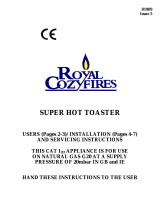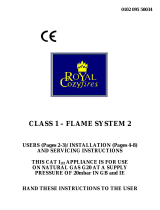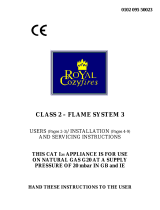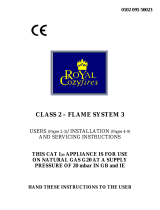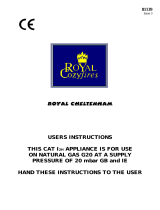Page is loading ...

0102 095 50261
6/,0/,1(67$1'$5'
USERS INSTRUCTIONS
THIS CAT I
3P
APPLIANCE IS FOR USE
ON PROPANE GAS G31 AT A SUPPLY
PRESSURE OF 37 mbar IN GB & IE
HAND THESE INSTRUCTIONS TO THE USER
DESCRIPTION

This Royal Cozy Fires Decorative Fuel Effect gas fire has been developed to give a realistic coal burning
appearance with the instant control and convenience of gas. The fire has been constructed to enable it to be
installed into applications where the warmth and comfort of an open fire and high radiant heat is required. This
appliance is intended for decorative purposes, the coal bed uses ceramic simulated coals to give a realistic
appearance and to allow secondary air to be entrained into the bed to ensure clean combustion. An aerated single
port steel burner is used running parallel across the front of the fire. A single gas control with a variable high to
low setting is used with a Flame Supervision Device (FSD). This is fitted to ensure that should the pilot flame be
extinguished for any reason, (including turning off the appliance), the gas supply to the burner is cut off until a
full lighting sequence is repeated. A separate Piezo igniter is used to ignite an Oxy/Pilot sensor (ODS) which will
cause the appliance to ’shut off’ in the event of continued spillage occurring under hazardous or blocked flue
conditions. The fire bed consists of ceramic fibre components and coals all of that are removable for cleaning
purposes when required. It is important when relaying the coal bed and coals to follow the instructions correctly.
TECHNICAL DATA
TYPE OF GAS G31 only
SETTING PRESSURE 37 mbar +/- 1 mbar (cold)
GAS INPUTS (Gross) Max 6 kW (20470 Btu/h)
Min 3.5 kW (11940 Btu/h)
Pilot 0.26 kW (890 Btu/h)
IMPORTANT NOTES
This appliance is intended for decorative purposes, it is designed and manufactured to the requirements of the BS
5258 Pt 16: 1991 and is for use on Propane Gas Only.
All gas appliance installations must be carried out by a competent person in accordance with the Gas Safety
(installation & Use) Regulations 1994 (as amended) or the rules in force and in accordance with the Manufacturers
Installation Instructions. Failure to comply could lead to prosecution.
The chimney or flue (unless new) must be swept before installation. It is recommended that the appliance be
serviced annually by a competent person and that the flue is checked for satisfactory clearance of products and
there is no excessive build up of soot. The curing effect of heating the coals will cause an initial odour which,
although not harmful, may require additional ventilation until the odour has disappeared.
Ventilation is required for this appliance with a minimum cross sectional area of 100 sq. cms and should be
checked regularly to ensure that it is free from obstruction.
The appliance has a naked flame, a fireguard conforming to BS 6539 or BS 6778 should be used for the
protection of the very young, elderly and infirm. Combustible materials should not be put on or left in the hearth
nor should the coal bed be used to burn rubbish or other materials.
Care must be taken on the selection of wall coverings within close proximity of the fire as some vinyl and
embossed materials may be become discoloured by convected heat. Soft furnishings must be kept clear from the
radiant heat of the fire and from impinging the hearth area. The hearth must not be covered by any combustible
materials such as carpets etc.
This product uses fuel effect pieces, gaskets and insulation material containing Refractory Ceramic Fibre
(RCF), which are man-made vitreous silicate fibres. Excessive exposure to these materials may cause
temporary irritation to eyes, skin and respiratory tract, consequently, it makes sense to take care when handling
these articles to ensure that the release of dust is kept to a minimum.
This fire will run for 2.2 hours on one kilogram of gas with the gas control on the high setting.
Page 2

One type of fire front and fret suggested is shown in Fig 1, this has a perforated fret to allow air to be drawn into
the coal bed for combustion and over the controls for cooling purposes. If other fronts and frets are to be used they
must have a minimum open area in the fret of 20 sq. cms and 60 sq. cms in the front. See Fig 1
This appliance is fitted with an Oxy-pilot which in the event of the flue being blocked, or hazardous conditions
causing the appliance to spill products of combustion, will shut ‘OFF’ the gas supply to the appliance. If the
sequence is repeated the appliance must be turned ’OFF’ and not used until expert advice has been obtained.
Clearance to Side
Minimum clearance required to any combustible material to the side of the appliance must be 150mm.
Clearance to Shelves
Minimum clearance to the underside of a 150mm deep combustible shelf from the hearth must be 790mm, add
12.5mm to this dimension for every 25mm increase in the depth of the shelf.
To light the appliance
Remove the fret (controls cover) to gain access.
Press and turn the gas control knob anti-clockwise until the indicator dot is opposite IGN. Keep the gas control
fully depressed.
Press and release the piezo igniter until the pilot flame situated in the centre behind the simulated coal front has lit.
Keep the gas control depressed for a further 10 to 15 seconds.
Release the gas control and check that the pilot flame remains lit. Refer to Fig 2 to view pilot.
Note: For convenience the unit can be operated with the pilot only, i.e. with the control knob set in the IGN
position.
Push in the gas control slightly and turn anti-clockwise so that the indicator dot is at the required setting. Replace
the fret (controls cover).
To turn off the appliance and pilot, turn the gas control clockwise from any position - until the indicator dot is
opposite ’OFF’.
IMPORTANT: After turning OFF or if the pilot and the appliance goes out for any reason, wait for three minutes
before attempting to relight.
Dismantling the Fire Bed for Cleaning
Allow the appliance to cool for 1 hour before handling any components.
Remove the coals, lift off the simulated coal front and the coal support shelf. Take out the lower fibre back and
side cheeks. Once all the fibre components have been removed from the firebed check that no debris has fallen in
or lodged the burner slots (both front and rear). If any debris is present it may be easily removed by using a small
piece of thin cardboard to ease out any foreign matter. Be sure to remove the cardboard after use. Should any soot
accumulation become excessive, the fuel effect pieces should be removed from the fire for cleaning. Cleaning
should be carried out in a well-ventilated area or in the open air, by gently brushing with the pieces held away
from your face so that you avoid inhaling the dust. We do not recommend the use of a normal domestic vacuum
cleaner, which may blow dust back into the air. Any sooty deposit on the thermocouple probe can be cleaned of
using a non-fluffy cloth.
Page 3

It is very important that the coals and the coal bed components are laid as shown no extra coals or material may be
used. If any of the items become lost or damaged, replacements must be obtained before further use of the
appliance.
Relaying the Coal Bed
Fit the coal support shelf (ensuring that the front edge sits behind the three tabs) and the simulated coal front. Fig
2
Referring to figures 2, 3 and 4 lay the coals as follows:
1. Place 4 large round coals between the simulated coal front and the support shelf. Fig 3
2. Place 3 round coals between the gaps in the front row. Fig 3
3. Place the 5 small round coals between the gaps formed in the coals laid in 1 & 2 above. Fig 4
Cleaning the Front of the Appliance
The fire must be turned off and allowed to cool. The paintwork should be cleaned with a soft cloth or soapy water;
the brass trim has a clear lacquer coating to preserve the polished finish.
Spares and Service
For spares and service contact your local supplier, installer or direct to the manufacturer stating that the appliance
is a Slimline De Luxe and quoting the serial number from the data label located on the fascia panel.
Advantage should be taken of regular servicing and inspection of gas appliances to ensure their continued safe
operation.
Short Parts List
Description Crosslee Pt No
Coal Support Shelves 42587
Front Simulated Coal 42769
Set of Coals 0102 078 01361

Page 4
Page 5

REGISTRATION RECORD
Purchaser’s Name__________________________________________________
and Address __________________________________________________
__________________________________________________
Supplier’s Name __________________________________________________
and Address __________________________________________________
__________________________________________________
Installer’s name__________________________________________________
and Address __________________________________________________
__________________________________________________
Date of Purchase__________________________________________________
Serial Number __________________________________________________
Please return this section with any components that are faulty under guarantee.
MAXIMUM HEAT INPUT
6 kW - 20470 Btu/h (Gross)
Royal Cozyfires are manufactured by:
CROSSLEE plc
Aber Park Industrial Estate,
Aber Road, Flint, Flintshire. CH6 5EX
Spares Tel 01422 203963
Fax: 01422 204475
Service (GSA Ltd) 01703 516611
Customer Service 01422 200660
Fax 01422 206304
*Technical Help Line 0906 8633268
*Calls charged at 50p per minute

0102 095 50251
6/,0/,1(67$1'$5'
INSTALLATION and
SERVICING INSTRUCTIONS
THIS CAT I
3P
APPLIANCE IS FOR USE
ON PROPANE GAS G31 AT A SUPPLY
PRESSURE OF 37 mbar IN GB & IE
HAND THESE INSTRUCTIONS TO THE USER

DESCRIPTION
This Royal Cozy Fires Decorative Fuel Effect gas fire has been developed to give a realistic coal burning
appearance with the instant control and convenience of gas. The fire has been constructed to enable it to be
installed into applications where the warmth and comfort of an open fire and high radiant heat is required.
This appliance is intended for decorative purposes, the coal bed uses ceramic simulated coals to give a
realistic appearance and to allow secondary air to be entrained into the bed to ensure clean combustion. An
aerated single port steel burner is used running parallel across the front of the fire. A single gas control with a
variable high to low setting is used with a Flame Supervision Device (FSD). This is fitted to ensure that
should the pilot flame be extinguished for any reason, (including turning off the appliance), the gas supply to
the burner is cut off until a full lighting sequence is repeated. A separate Piezo igniter is used to ignite an
Oxy/pilot sensor (O.D.S) that will cause the appliance to ‘shut off’ in the event of continued spillage
occurring under hazardous or blocked flue conditions. The fire bed consists of ceramic fibre components and
coals all of that are removable for cleaning purposes when required. It is important when relaying the coal bed
and coals to follow the instructions correctly.
This appliance is suitable for installations into the following flues:
7" minimum diameter flues (CLASS 1),
5" minimum diameter flues (CLASS 2),
Pre-cast flues to BS 1289 Pt 1 1986
The installations must always be used in conjunction with a suitable hearth and surround. .
TECHNICAL DATA
Overall height of fire = 602 mm
Overall width of fire = 505 mm
Minimum height of opening required = 550 mm
Minimum width of opening required = 396 mm
Forward projection from opening = 50 mm
(without front & fret)
Depth behind opening = 122 mm
TYPE OF GAS G31 Only
Supply Pressure 37 mbar +/- 1mbar (Cold)
GAS INPUTS (Gross)
Max 6 kW (20470 Btu/h)
Min 3.5kW (11940 Btu/h)
Pilot 0.26 kW ( 890 Btu/h)
Main Injector Type
Stereomatic 046-19-196-047M
Pilot
OP. Oxy/Pilot 1PG 9214
GAS CONNECTION
8mm O/D Tube
WEIGHT 11.5 kg without front & fret 14.5 kg with front & fret.
Page 2

Installation Regulation and Requirements
The appliance must be installed by a competent person in accordance with the current Gas Safety (Installation
and Use) Regulations 1994 (as amended) or the rules in force and in accordance with the manufacturers
instructions, failure to do so could lead to prosecution.
The following are the relevant Codes of Practice and British Standards.
The Building Regulations issued by the Department of the Environment
The Building Standards (Scotland)(Consolidation) Regulations issued
by the Scottish Development Department.
BS 8303 1986 BS 5440 Pt1 1990 & Pt2 1989
BS 1251 1987 BS 5871 Pt2 1991 & Pt3 1991
BS 6891 1988 BS 6461 Pt1 1984
BS 715 1993 BS 1289 Pt1 1986
BS 7566 Pts 1-4 1992
Important Notes
Areas of this appliance will become hot after prolonged running and it is recommended that for the protection
of the very young, elderly and infirm a fireguard conforming to BS 6539 or BS 6778 be used.
The type of front and fret recommended is shown in this instruction, it has a perforated fret to allow air to be
drawn into the coal bed for combustion and over the controls for cooling purposes. If other fronts and frets
are to be used they must have a minimum open area in the fret of 20 sq. cms and 60 sq. cms in the front.
Care should be taken to prevent any damage being caused to surrounding soft furnishings or decor e.g. many
embossed vinyl wall coverings may become discoloured if located too close to the appliance. Clearances
required for combustible shelves are shown in fig 1.
Care should be taken to ensure that when the appliance is installed into a Pre-cast flue, the chimneybreast is
lined to prevent the plaster etc, cracking through excessive temperatures.
A hearth must always be provided to project forward of the opening a minimum of 340mm depth and 150mm
either side of the fire opening. The hearth must be a minimum thickness of 12mm with a perimeter height of
50mm, to deter combustible materials, carpets etc, being placed on the hearth.
The area under the firebox must have a minimum non-combustible thickness of 25mm.
In most installations a back panel will be required, this will also need a minimum fire resistance rating of
Class 0 (100
O
C).
Ventilation is required for this appliance with a minimal cross sectional area of 100 sq. cms and should be
checked regularly to ensure that it is free from obstruction.
The chimney or flue (unless new) must be swept before installation. It should be checked annually when the
appliance is serviced for spillage (smoke test) and that there is no excessive build up of soot.
Page 3

Fire Surround and Opening Requirements
Check that the chimney and flue structure are sound and conform to the following flue requirements:
a) A conventional brick or stone chimney with a minimum effective cross sectional dimension of
225x225mm. A lined flue with a minimum diameter of 175mm having a chairbrick and throat forming lintel
conforming to BS 1251 or a builders opening measuring 560mm high x 400mm wide with a depth of 185mm
minimum for debris collection. If a chairbrick is fitted, a minimum depth requirement for the fire is shown in
fig 2.
b) A twin walled metal flue box manufactured to BS 715 with a twin walled 125mm-diameter flue and a
minimum effective height of 3 metres. See figs 3&4.
c) A pre-cast flue conforming to the requirements of BS 1289 Pt 1 1986 and BS 1289 1975 including properly
constructed pre-cast flues with a cross sectional area of 13000sq mm. See figs 5&6.
Important
Dampers, register plates or incorrect flue terminals, must not restrict any of the above flues. The flue must
only service a single appliance and not have any branches or traps that may impede the natural draught. Any
flue damper plate or restrictors shall be removed or fixed in the fully opened positions.
The front and base of the fire opening must be flat and square to ensure a good seal with the appliance; this is
to ensure that there is no reduction in draught through the fire that may cause spillage to occur.
Clearance to Side (timber surrounds etc)
Minimum clearance required to any combustible material to the side of the appliance must be 15Omm. Fig 1.
Clearance to Shelves
Minimum clearance to the underside of a 15Omm deep combustible shelf from the hearth must be 79Omm.
Add 12.5mm to this clearance for every 25mm increase in depth of shelf. Fig 1.
Contents Check List
Fire Box Assembly c/w Burner Assembly Coal Pack including: -
Brass Trim Coal pack A - 5 Small
Coal Support Shelf Coal Pack B - 7 Large
Simulated Coal Front
Fitting Kit: -
Screws & Wall Plugs, Cable Kit, Isolation Elbow, Bundy.
Installation and Servicing Instructions
Users Instructions
Page 4

Installation of the Appliance
Check that the chimney conforms to the required specifications as previously stated. Examine the condition
and carry out any remedial work as necessary, if the flue has been used for solid fuel it should be swept and a
smoke test carried out to check that satisfactory smoke clearance has been established. If all the smoke is not
drawn into the flue, pre-heat the flue with a blowtorch or similar and re-check. If there is any uncertainty
examine for the cause and if necessary seek expert advice.
Gas Supply
BEFORE COMMENCING WORK, TURN OFF ANY APPLIANCES THAT ARE FED BY THE
SUPPLY AND ISOLATE THE GAS SUPPLY BY TURNING OFF AT THE SUPPLY
The gas connection to this appliance is made with 8mm o/d rigid or semi rigid tube to a pressure test elbow
situated on the L/H side of the burner as shown in Fig 10. It is advisable to provide a means of isolating the
gas supply to the appliance for servicing using the isolation cock supplied. Provision is made i.e. knock-out
blanks for entry into the box in both L&R hand rear corners and at the L&R hand sides although for ease of
installation, it is recommended that the gas feed is made from the left hand side. Any pipe used under the tray
must be in rigid tube such as bundy, suitable pieces of bundy are included in the fitting kit to assist the
installer.
Where a concealed gas supply is used, the installer is reminded of the requirements of BS 6891 - 1988 dealing
with enclosed pipes. The Standard requires that when a gas pipe is fed through a wall, the pipe should be
enclosed in a tight sleeve to protect against failure caused by movement and shall be constructed to prevent
passage of gas either between the pipe and sleeve or sleeve and wall.
Where a gas supply pipe enters the box in any of the positions stated, the hole around the pipe should be
sealed with a silicone sealant or similar to prevent ingress of air into the flue. Permanent sealant e.g. fire
cement etc. should not be used as these would prevent removal of the firebox if so required.
Dismantling the fire prior to Installing.
It will be necessary to dismantle the burner from the firebox before installing the box in the opening.
To remove the burner, unscrew the two screws on the front flange of the burner, lift and pull forward.
Important
THE RESTRICTOR PLATE MUST NOT BE USED WITH 5" OR PRE-CAST FLUES
The restrictor is for use with 7in (175mm) diameter flues only.
The appliance is supplied without a Flue Restrictor fitted in position i.e. suitable for 5" or pre-cast flues.
The restrictor plate is fitted prior to installing the firebox and is held in position with the two self-tap screws
provided. See Fig 9
Page 5

Installing the Appliance in Position
When the gas supply pipe has been laid to the position required, the surround should be fitted and sealed to
the chimney correctly. This is to prevent any seepage of flue products or to prevent any ingress of air into the
flue from anywhere other than the flue outlet of the fire. The easier method of installation is through the holes
provided in the front face of the vent box - this method will require drilling into the back panel of the
surround. See Fig 8. Where it is undesirable to deface or damage the back panel, a cable fixing kit is provided
which can be fastened to the inner walls of the opening and the back of the box, see Fig 9.
Before offering the vent box into the opening, the hearth should be protected from damage or scratches that
may occur during installation.
Locate and secure the firebox by the method chosen ensuring that a good seal exists with the back panel. Lay
a gas supply to the location of the burner connecting elbow and place the burner into the vent box locate the
facia panel cut-out over the flange on the baseplate and secure into position with the 2 x No 8 self tap screws
supplied - complete the gas connection.
Note: The complete installation should be tested for Gas soundness.
Fit the brass trim in position and remove the plastic coating from the brass finish.
Laying the Coal Bed
Fit the coal support shelf (ensuring that the front edge sits behind the three tabs) and the simulated coal front.
Fig 10.
Referring to figures 10, 11, 12 and 13 lay the coals as follows: -
1. Place 4 large round coals between the simulated coal front and the support shelf. Fig 12
2. Place 3 round coals between the gaps in the front row. Fig 12
3. Place the 5 small round coals between the gaps formed in the coals laid in 1 & 2 above. Fig 13
Checking Operation of Fire
Turn on the Gas supply at the meter and to the appliance at the isolating cock. Purge the air to the appliance.
Rotate the control knob to the ignition position, depress the control and push the piezo to ignite the pilot.
Check that the electrode is sparking between the tip of the thermocouple and continue until a pilot ignition is
established. Depress the control knob slightly and rotate anti-clockwise until the index symbol is aligned with
the small flame symbol on the indicator label. Release and rotate the control knob to the high position (large
flame symbol) and check that the flame picture is satisfactory, then release the control knob - if the pilot does
not stay alight repeat until the pilot remains alight with the knob released. Turn the gas control to the OFF
position, wait for 90 seconds, fully depress the gas control, turn to the ignition position and release the
control. Attempt to light the pilot with an already prepared match or taper, if the pilot lights the FSD is faulty.
Page 6

To check the gas pressure at the appliance, allow the coals and the coal bed to cool and turn off the gas supply
at the isolating cock. Remove the hexagon headed screw and connect a manometer to the pressure test point,
turn on the gas and ignite the fire, allow to heat up and check that the gas pressure is 37 mbar +/- 1 mbar - any
appreciable drop may indicate restrictions through the pipework up to the fire. The pressure test point may
also be used to check for leakage of the joints to the appliance. Allow the coal bed to cool before replacing
the screw.
Spillage Check
Light the appliance and set to the large flame position, locate the front and fret in position and leave to warm
up for 5 minutes. Check for satisfactory clearance of combustion products by positioning a lighted smoke
match 20mm down from edge of canopy, 80mm from either side and 45mm back from the front edge. All the
smoke must be drawn into the flue see Fig 8A. If spillage occurs, allow a further 10 minutes. Should spillage
still occur, disconnect the appliance and examine the chimney for the fault and rectify. If an extractor fan is
situated in the room, the test should be repeated with the fan running. If there is a connected room, the test
should be repeated with all the doors in that room opened.
Demonstrate the lighting and extinguishing procedures to the user.
Advise that:
The curing effect of heating the coals will cause an initial odour which, although not harmful, may require
additional ventilation until the odour has disappeared.
Any debris or soot is cleaned from the appliance. Advise the customer that they should read their Users
Instructions before operating the fire and always follow the advice in the section headed ‘Removal of
Debris or Soot Deposits’. The appliance must be serviced annually by a competent person in accordance with
these instructions; at this time the appliance should be re-checked for spillage in accordance with the method
detailed in these instructions.
If the appliance is turned ‘off’ or shuts off automatically, wait for at least 3 minutes before attempting to
relight.
The appliance is fitted with an Oxy-pilot to prevent the continued operation in the event of spillage occurring.
If the fire shuts `OFF' repeatedly the appliance must be turned off and not used until an expert is consulted.
Complete the registration section at the end of this booklet. Advise that any component part of this appliance
be guaranteed against defective workmanship or faulty materials for a period of twelve months from the date
of purchase.
Any such part will be replaced free of charge on receipt of the purchasers address at the cost of postage only,
provided that:
a. It is accompanied by the registration section cut out of the booklet, together with the original purchase
receipt, which will be returned with the replacement part.
b. A competent person has carried out any installation, repairs or adjustments, such as the supplier’s
representative or a CORGI registered installer.
Page 7

Maintenance and Servicing
GENERAL
A. REMOVAL OF DEBRIS OR SOOT DEPOSITS
Allow the appliance to cool sufficiently before removing all of the coals and firebed components for cleaning
purposes. Once all the ceramics are removed from the firebed check that no debris is located in the burner
slots (both front and rear). If any debris is present it may easily be removed by using a small piece of thin
cardboard to ease out any foreign matter. Be sure to remove the cardboard after use. To ensure that the
release of fibres from these RCF articles is kept to a minimum, during installation and servicing we
recommend that you use a HEPA filtered vacuum to remove any dust and soot accumulated in and around
the fire before and after working on the fire. When replacing these articles we recommend that the replaced
items are not broken up, but are sealed within heavy duty polythene bags, clearly labelled as RCF waste.
This is not classified as "hazardous waste" and may be disposed of at a tipping site licensed for the disposal
of industrial waste. Protective clothing is not required when handling these articles, but we recommend you
follow the normal hygiene rules of not smoking, eating or drinking in the work area and always wash your
hands before eating or drinking. Any sooty deposit on the thermocouple probe can be cleaned off using a
non-fluffy cloth.
DO NOT USE ABRASIVE MATERIALS
B. SERVICING COMPONENTS BELOW THE BURNER ASSEMBLY
(Turn OFF the gas supply to the appliance.)
Remove coals, coal supports, burner inserts and front simulated coal. To gain access to components below the
burner assembly it has to be removed from the vent box case by disconnecting the gas supply at the inlet
elbow and unscrewing the two screws on the sides of the facia panel. Where the supply is fed from the right
hand side across the front of the fire it will be necessary to disconnect the supply from the isolation tap/elbow.
i) TO CLEAN OR REPLACE THE INJECTOR: Remove the aeration sleeve retaining screw unscrew
the compression nut connecting the gas supply to the elbow injector while supporting the injector to prevent
distortion of the framework. Unscrew and remove the gas supply tube from the gas control valve, hold the
injector lock nut with a spanner and rotate the injector. Replace in reverse order - ensure the aeration sleeve
retaining screw is replaced.
ii) TO REPLACE THE GAS CONTROL (Tap/FSD): Disconnect the three gas pipes and the
thermocouple from the control. Pull off the knob and lay to one side. Undo the retaining nut at the front of
the tap niting assembly to withdraw control from the mounting bracket. Replace in reverse order.
iii) TO REPLACE THE PIEZO IGNITER: Pull off the HT lead from the rear of the igniter. Retain the
metal fixing nut with one finger and rotate the body of the igniter to unscrew. Withdraw the igniter from the
front. Replace in reverse order and reconnect the HT lead.
iv) TO REPLACE THE OXY-PILOT ASSEMBLY: The assembly is not an item that can be serviced as
part of its calibration depends on the proximity of the spark electrode and thermocouple tip. The assembly can
be replaced by removing the tube nut and tube from the base of the pilot and the thermocouple from the FSD
also the igniter lead and the two screws securing the bracket to the framework. Replace in reverse order, the
spark gap is shown in fig 14.
Page 8

Page 9

Page 10

Page 11


Page 12

Page 13
/

